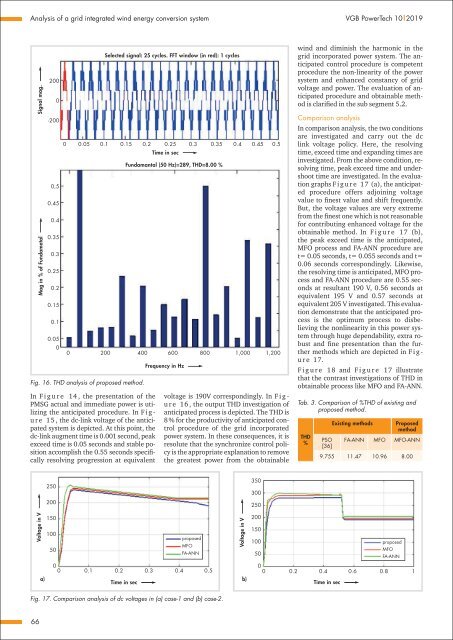VGB POWERTECH 10 (2019)
VGB PowerTech - International Journal for Generation and Storage of Electricity and Heat. Issue 10 (2019). Technical Journal of the VGB PowerTech Association. Energy is us! Cyber security. Power generation. Environment. Flexibility.
VGB PowerTech - International Journal for Generation and Storage of Electricity and Heat. Issue 10 (2019).
Technical Journal of the VGB PowerTech Association. Energy is us!
Cyber security. Power generation. Environment. Flexibility.
Sie wollen auch ein ePaper? Erhöhen Sie die Reichweite Ihrer Titel.
YUMPU macht aus Druck-PDFs automatisch weboptimierte ePaper, die Google liebt.
Analysis of a grid integrated wind energy conversion system <strong>VGB</strong> PowerTech <strong>10</strong> l <strong>2019</strong><br />
Signal mag.<br />
Mag in % of Fundametal<br />
200<br />
0<br />
-200<br />
0,5<br />
0.45<br />
0.4<br />
0.35<br />
0.3<br />
0.25<br />
0.2<br />
0.15<br />
0.1<br />
0.05<br />
0<br />
In F i g u r e 14 , the presentation of the<br />
PMSG actual and immediate power is utilizing<br />
the anticipated procedure. In F i g -<br />
u r e 1 5 , the dc-link voltage of the anticipated<br />
system is depicted. At this point, the<br />
dc-link augment time is 0.001 second, peak<br />
exceed time is 0.05 seconds and stable position<br />
accomplish the 0.55 seconds specifically<br />
resolving progression at equivalent<br />
Selected signal: 25 cycles. FFT window (in red): 1 cycles<br />
0 0.05 0.1 0.15 0.2 0.25 0.3 0.35 0.4 0.45 0.5<br />
Time in sec<br />
Fundamantal (50 Hz)=289, THD=8.00 %<br />
0 200 400 600 800 1,000 1,200<br />
Fig. 16. THD analysis of proposed method.<br />
Frequency in Hz<br />
voltage is 190V correspondingly. In F i g -<br />
u r e 16 , the output THD investigation of<br />
anticipated process is depicted. The THD is<br />
8 % for the productivity of anticipated control<br />
procedure of the grid incorporated<br />
power system. In these consequences, it is<br />
resolute that the synchronize control policy<br />
is the appropriate explanation to remove<br />
the greatest power from the obtainable<br />
wind and diminish the harmonic in the<br />
grid incorporated power system. The anticipated<br />
control procedure is competent<br />
procedure the non-linearity of the power<br />
system and enhanced constancy of grid<br />
voltage and power. The evaluation of anticipated<br />
procedure and obtainable method<br />
is clarified in the sub segment 5.2.<br />
Comparison analysis<br />
In comparison analysis, the two conditions<br />
are investigated and carry out the dc<br />
link voltage policy. Here, the resolving<br />
time, exceed time and expanding times are<br />
investigated. From the above condition, resolving<br />
time, peak exceed time and undershoot<br />
time are investigated. In the evaluation<br />
graphs F i g u r e 17 (a), the anticipated<br />
procedure offers adjoining voltage<br />
value to finest value and shift frequently.<br />
But, the voltage values are very extreme<br />
from the finest one which is not reasonable<br />
for contributing enhanced voltage for the<br />
obtainable method. In F i g u r e 17 (b),<br />
the peak exceed time is the anticipated,<br />
MFO process and FA-ANN procedure are<br />
t= 0.05 seconds, t= 0.055 seconds and t=<br />
0.06 seconds correspondingly. Likewise,<br />
the resolving time is anticipated, MFO process<br />
and FA-ANN procedure are 0.55 seconds<br />
at resultant 190 V, 0.56 seconds at<br />
equivalent 195 V and 0.57 seconds at<br />
equivalent 205 V investigated. This evaluation<br />
demonstrate that the anticipated process<br />
is the optimum process to disbelieving<br />
the nonlinearity in this power system<br />
through huge dependability, extra robust<br />
and fine presentation than the further<br />
methods which are depicted in F i g -<br />
ure 17.<br />
Figure 18 and Figure 17 illustrate<br />
that the contrast investigations of THD in<br />
obtainable process like MFO and FA-ANN.<br />
Tab. 3. Comparison of %THD of existing and<br />
proposed method.<br />
THD<br />
%<br />
PSO<br />
[36]<br />
Existing methods<br />
Proposed<br />
method<br />
FA-ANN MFO MFO-ANN<br />
9.755 11.47 <strong>10</strong>.96 8.00<br />
Voltage in V<br />
250<br />
200<br />
150<br />
<strong>10</strong>0<br />
proposed<br />
MFO<br />
50<br />
FA-ANN<br />
0<br />
0 0.1 0.2 0.3 0.4 0.5<br />
a)<br />
Time in sec<br />
Voltage in V<br />
b)<br />
350<br />
300<br />
250<br />
200<br />
150<br />
<strong>10</strong>0<br />
proposed<br />
MFO<br />
50<br />
FA-ANN<br />
0<br />
0 0.2 0.4 0.6 0.8 1<br />
Time in sec<br />
Fig. 17. Comparison analysis of dc voltages in (a) case-1 and (b) case-2.<br />
66


















